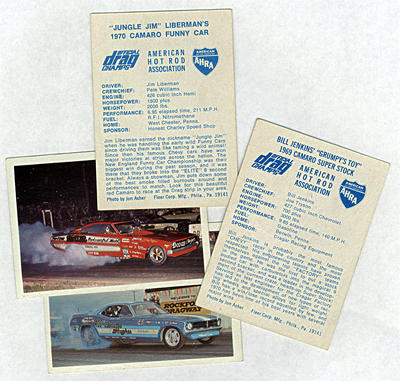|
|
 |
|
 |
||
| TRADING CARDS - A LOOK BACK AND A LOOK FORWARD
Drag racing fans should be so lucky. There have been drag racing cards printed either as part of larger automotive sets or as inclusive drag racing issues since the 1960s. There were also several sets done when the NASCAR trading card hobby took off in the 1988-1994 era. While none are currently being released for actual sale for the general market, racers sometimes issue cards for distribution from their pit areas. Though some are very scarce (low private issue, prototypes), it is still possible to create a sizable and impressive collection if one desires to do so. The earliest cards were done by the big-name printing companies. Topps and Donruss each did a hot rod/custom-oriented set in 1965, both of which included drag cars. These were followed by a set of larger black-and-white cards used as backing boards for stickers called Stickshifts and Dragstrips. Then, in 1971, Fleer made a deal with AHRA and did the first of three sets. The first set, which had 63 cards, was called Official Drag Champs, and was done in both American and Canadian issues. The only difference between the two besides the location of printing is that the Canadian cards are numbered on the back. The following year saw the debut of Drag Nationals, which are considered the toughest of the trio, and numbered 70 cards, with photography by Jim Kelly. The final set numbered 74 cards and was called Race USA, featuring two-year-old pictures from the 1972 Winter Nationals at Beeline Raceway in Arizona. Neil Mahr's SuperPress Company did a scarce set of cards in the late Seventies as well. Things were quiet for 10 years or so, then Megacards and Racing Legends both jumped into the foray in 1989. Megacards did a 110-card set of general drag racing and Racing Legends began to do yearly issues on IHRA. Pro Set began doing NHRA card sets in 1991, and became the first to have complete national distribution through trading card dealers. These were followed by sets from Action Packed and Finish Line, but the genre never seemed to stick, and after about a five-year bubble, the trading card industry decided that drag racing was not the place to make big bucks. The major value of these later issues is normally found in the inserted, limited-run autograph or holographic cards. One has to wonder if the ready availability of complimentary handouts in the pits had an effect on potential trading card sale-through. As mentioned, there are also an uncountable number of private issue "hero" trading cards, independent team or group series, low production sets, failed attempts at publishing and more. These cards have got limited appeal except to serious trading card collectors, who will spend time and money acquiring issues they don't have yet. Due to the fact they are often free, they also constitute a challenge to those who are simply trying to add to the cards they purchased during the "boom" years. Pricing is fluid on trading cards. The highest demand issues are the Fleer AHRA cards and the scarce SuperPress and Dragstrips/Stickshifts odd-size cards. Some examples may well be over $10 each, with $3-$5 each being an average number for well-printed unmutilated originals. On the other hand, the '90s issues can still be found, sometimes as full boxes of unopened packs, and that is sometimes a buyer's market; they need to "age" some more before they will see any appreciation. The independent issues average $1-$5 each, based on subject matter. What does the future hold? While it is doubtful that drag racing trading cards will ever achieve the status of traditional sports cards, each set offers a very good glimpse into the way drag racing looked at the time they were issued. Though outlets are slim for quality material, if you are diligent it is possible to amass most of the best-known card sets either piecemeal or in complete groups. Unlike larger collectibles, they are also easiest to store. - - - - |
||
 |
||
|
Copyright 1999-2001, Drag Racing Online and Racing Net Source |
||
 Unless
you are a collector of such, it is almost unfathomable what certain
trading cards are selling for in today's market. Recently, a rare baseball
card, just one, topped over $1,000,000 at auction, and there are many
individuals who actually make a comfortable living selling either new
or "high-quality pre-owned" trading cards. In the current economy, the
sky is still the limit in this field, at least in ball-and-stick issues.
Unless
you are a collector of such, it is almost unfathomable what certain
trading cards are selling for in today's market. Recently, a rare baseball
card, just one, topped over $1,000,000 at auction, and there are many
individuals who actually make a comfortable living selling either new
or "high-quality pre-owned" trading cards. In the current economy, the
sky is still the limit in this field, at least in ball-and-stick issues.